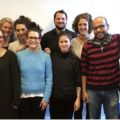Visiting faculty testimonial: Professor Ken Light
Read UC Berkeley Professor Ken Light's report of his visit to University of Amsterdam, the Danish School of Media and Journalism and Aarhus University, in May and June 2015.

My visit included long conversations with new colleagues about our programs and photography. This interaction was inspiring especially since they were open with sharing ideas and programmatic details and teaching methods. It is especially important to hear ways that my Danish and Dutch partners are working to meet the challenges of the changing face of global journalism.
Ken Light, Reva and David Logan Professor of Photojournalism, U.C. Berkeley Graduate School of Journalism
As head of the U.C. Berkeley photojournalism program, it was very stimulating to travel out of the United States to meet my colleagues and the students of the Erasmus Mundus Journalism program in both the Netherlands and Denmark.
The ideas of such exchanges are so important, as it is easy for us to remain in our own cultural spheres without absorbing new points of view. Visiting the Mundus programs allowed me to exchange ideas with my colleagues, and share my experiences with numerous students groups. My visit included long conversations with new colleagues about our programs and photography. This interaction was inspiring especially since they were open with sharing ideas and programmatic details and teaching methods. It is especially important to hear ways that my Danish and Dutch partners are working to meet the challenges of the changing face of global journalism.
Amsterdam
My first day of my visit included talking with each of the Mundus Journalism students who had created a poster “pitch session” for their thesis journalistic pieces. This was one of the final meetings of this component of their thesis. I had the opportunity to meet and talk with each of these students individually, look at their pitch, and share my ideas. This meeting was very exciting, as the Mundus students come from a broad European geographical swath. I heard from students from Catalonia, Italy, Moldavia, France and other EU countries, which allowed me to see and hear what young journalist are thinking and how they are trying to explain stories that impact their cultures. I enjoyed the give-and-take and sharing of ideas, and learning how they see themselves as journalists in this new era of reporting and story telling.
The following day I held a workshop for a group of Mundus Journalism students where l presented a PowerPoint about photojournalism/photography with images of American photographers that influenced my path as a photojournalist. This led to a lively discussion about photos, visual story telling and history. Many of the photos portray historical images of issues such as child labor in the early 20th century, and America’s Great Depression. This created an atmosphere for discussion about how we visualize important events both as a witness, but also as visual historians in our time. It was an exciting to hear these students’ ideas and the European perspective on the use of photos in the mass media. These students were very interested in how the mass media has changed and how visual journalists can develop new strategies for communicating difficult stories.
Aarhus
My visit to Aarhus included talking and meeting with students in the international program, and also learning about the photojournalism program. I enjoyed spending a day with Dean Henrik Jørgensen talking about journalism and hearing about the programs at the Danish School of Media and Journalism.
I spent time talking with my colleague Søren Pagter, director of the photojournalism program and touring the photo facilities in Aarhus. We visited the darkroom lab, the mac/digital editing rooms, and watched students working on layouts for their final projects. It was inspiring to see the numerous magazine photo publications and design projects that adorned the hallways of the building where the program is housed.
I presented a lecture called “Education of a Photographer,” looking at historical figures in photography and my own evolution to journalism reportage. After the talk I interacted with numerous students who wanted to talk about my methods and various projects I had introduced to them.
One of my favorite exchanges was with a small class that is studying freelance journalism with Anne Rhode. Faculty member Mads Greve joined me in visiting Rhode’s class. I presented a PowerPoint of my reportage project on Texas Death Row. It was a lively presentation and students and I talked about the importance of reportage, gaining access, and making a living as a journalist. Many of the students asked to join me on Facebook and LinkedIn, so that we could continue to be in touch.
I used the third week of my visit for photojournalistic research, photographing throughout Denmark. I was looking at how people are interacting with the landscape, and how tourists interact with many of the cultural icons found in Denmark.
My Berkeley colleagues have talked to me about their wonderful experiences in the past, and now I truly understand why. It is now evident to me how much mutual benefit there is for both the Mundus program and for the program in Berkeley. I made wonderful contacts and broadened my understanding of European journalism and reportage.